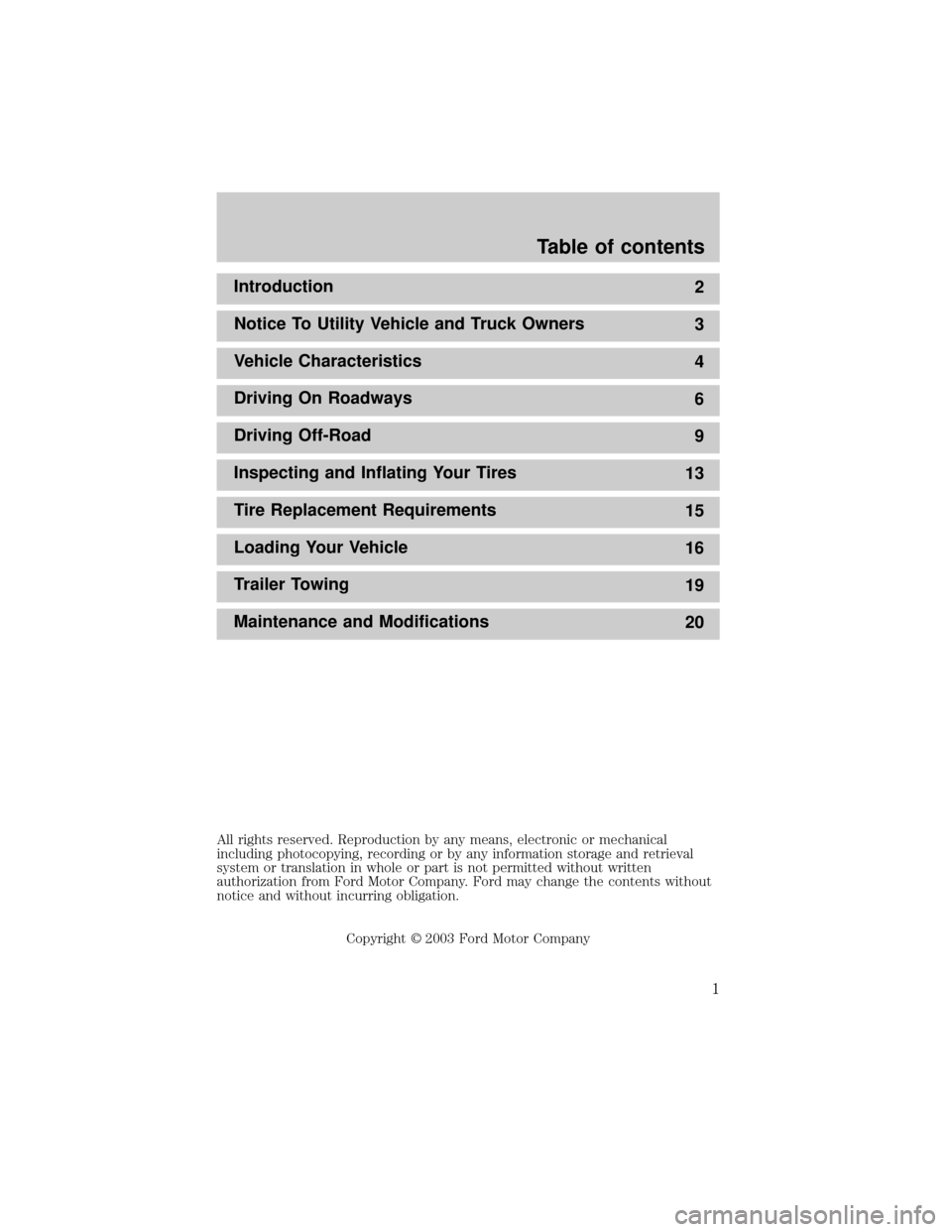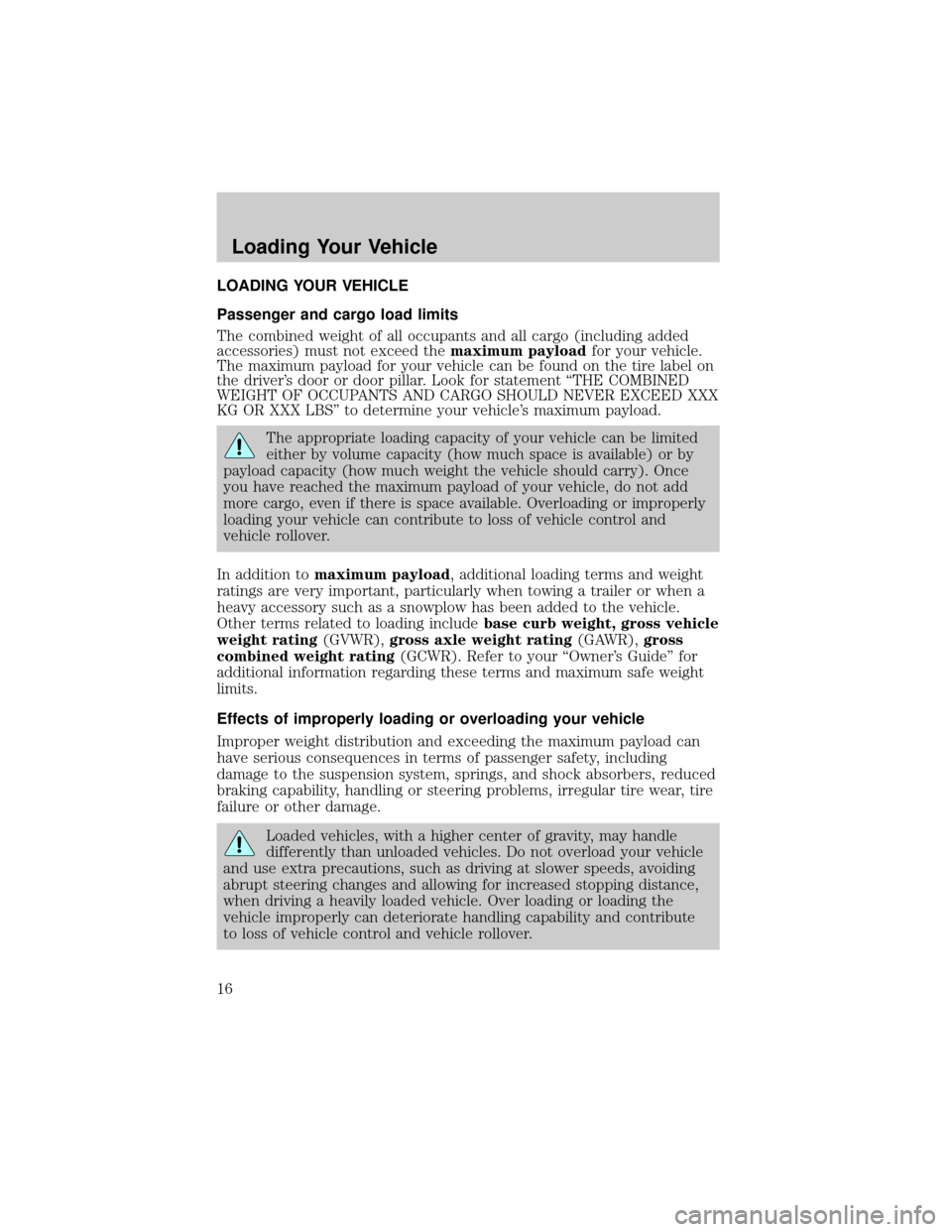tow Mercury Mountaineer 2007 Manual de Usuario (in Spanish)
[x] Cancel search | Manufacturer: MERCURY, Model Year: 2007, Model line: Mountaineer, Model: Mercury Mountaineer 2007Pages: 48, tamaño PDF: 0.37 MB
Page 25 of 48

Introduction
2
Notice To Utility Vehicle and Truck Owners
3
Vehicle Characteristics
4
Driving On Roadways
6
Driving Off-Road
9
Inspecting and Inflating Your Tires
13
Tire Replacement Requirements
15
Loading Your Vehicle
16
Trailer Towing
19
Maintenance and Modifications
20
All rights reserved. Reproduction by any means, electronic or mechanical
including photocopying, recording or by any information storage and retrieval
system or translation in whole or part is not permitted without written
authorization from Ford Motor Company. Ford may change the contents without
notice and without incurring obligation.
Copyright 2003 Ford Motor Company
Table of contents
1
Page 40 of 48

LOADING YOUR VEHICLE
Passenger and cargo load limits
The combined weight of all occupants and all cargo (including added
accessories) must not exceed themaximum payloadfor your vehicle.
The maximum payload for your vehicle can be found on the tire label on
the driver's door or door pillar. Look for statement ªTHE COMBINED
WEIGHT OF OCCUPANTS AND CARGO SHOULD NEVER EXCEED XXX
KG OR XXX LBSº to determine your vehicle's maximum payload.
The appropriate loading capacity of your vehicle can be limited
either by volume capacity (how much space is available) or by
payload capacity (how much weight the vehicle should carry). Once
you have reached the maximum payload of your vehicle, do not add
more cargo, even if there is space available. Overloading or improperly
loading your vehicle can contribute to loss of vehicle control and
vehicle rollover.
In addition tomaximum payload, additional loading terms and weight
ratings are very important, particularly when towing a trailer or when a
heavy accessory such as a snowplow has been added to the vehicle.
Other terms related to loading includebase curb weight, gross vehicle
weight rating(GVWR),gross axle weight rating(GAWR),gross
combined weight rating(GCWR). Refer to your ªOwner's Guideº for
additional information regarding these terms and maximum safe weight
limits.
Effects of improperly loading or overloading your vehicle
Improper weight distribution and exceeding the maximum payload can
have serious consequences in terms of passenger safety, including
damage to the suspension system, springs, and shock absorbers, reduced
braking capability, handling or steering problems, irregular tire wear, tire
failure or other damage.
Loaded vehicles, with a higher center of gravity, may handle
differently than unloaded vehicles. Do not overload your vehicle
and use extra precautions, such as driving at slower speeds, avoiding
abrupt steering changes and allowing for increased stopping distance,
when driving a heavily loaded vehicle. Over loading or loading the
vehicle improperly can deteriorate handling capability and contribute
to loss of vehicle control and vehicle rollover.
Loading Your Vehicle
Loading Your Vehicle
16
Page 43 of 48

TRAILER TOWING
Your vehicle may be equipped for towing trailers (or may require a trailer
tow package). Before you operate your vehicle with a trailer, make sure
that you comply with the guidelines in the ªRV & Trailer Towing Guideº.
The combined total weight of the vehicle and trailer must be less than or
equal to the recommended Gross Combination Weight Rating (GCWR)
and be properly balanced and secured. Refer to ªRV & Trailer Towing
Guide,º the ªOwner's Guideº or see an authorized Ford or
Lincoln/Mercury Dealer for additional information.
Trailer Towing
Trailer Towing
19